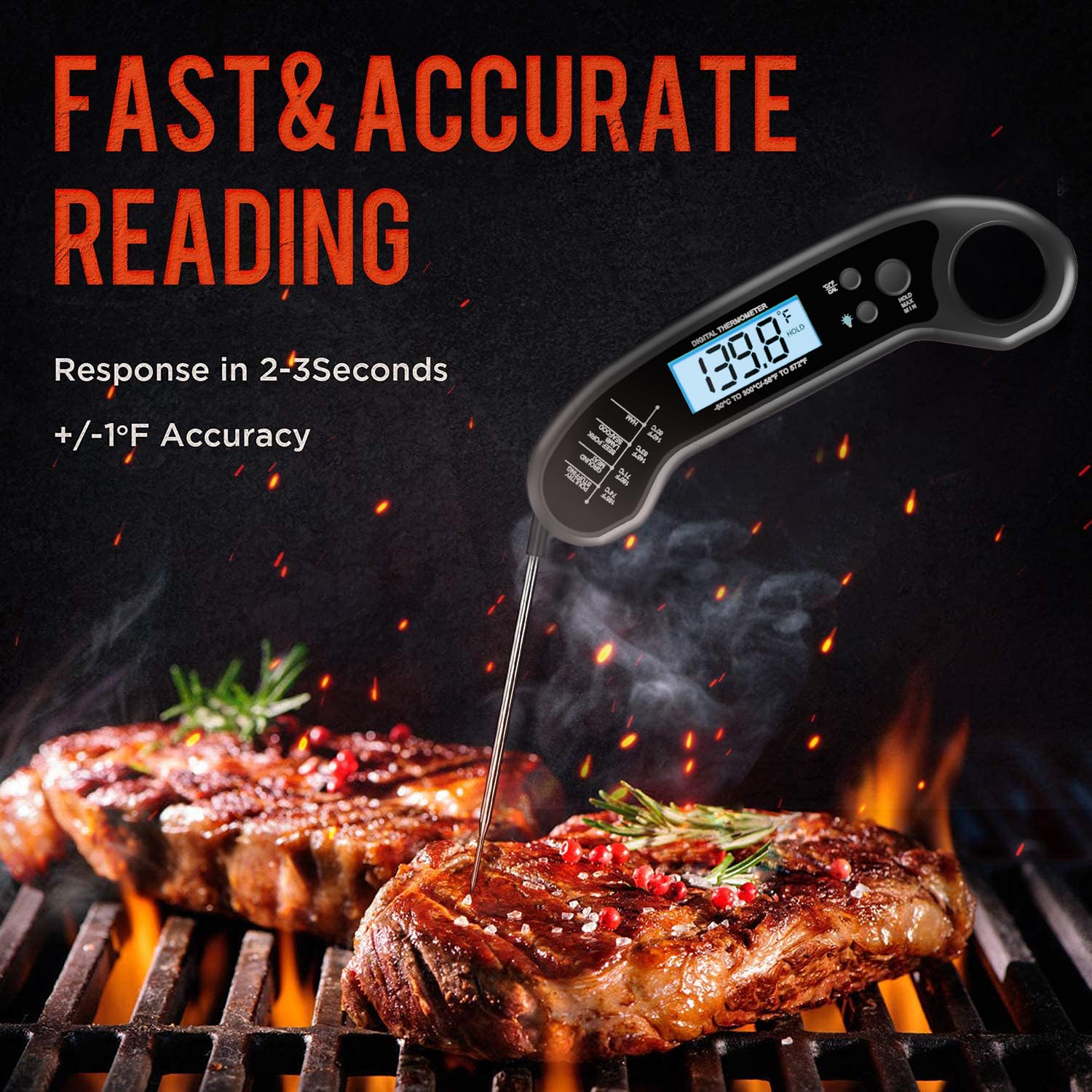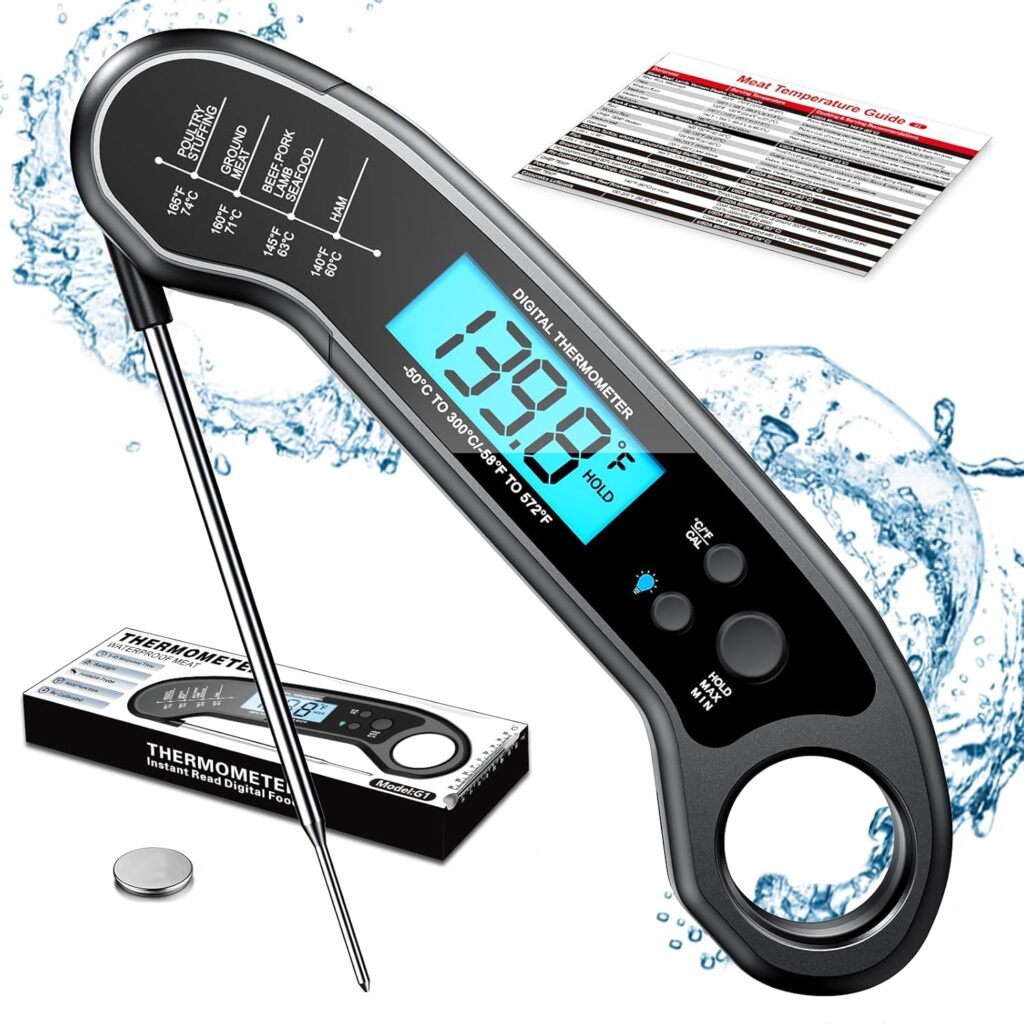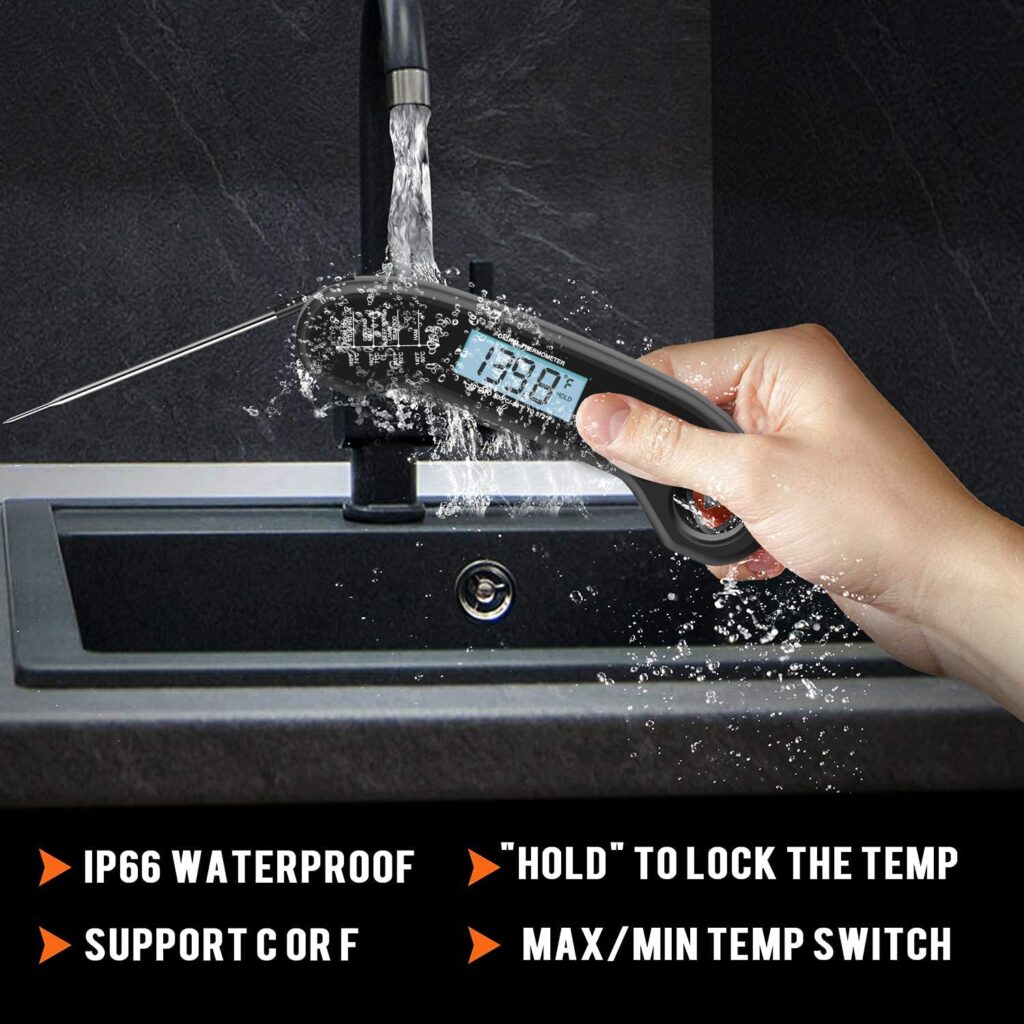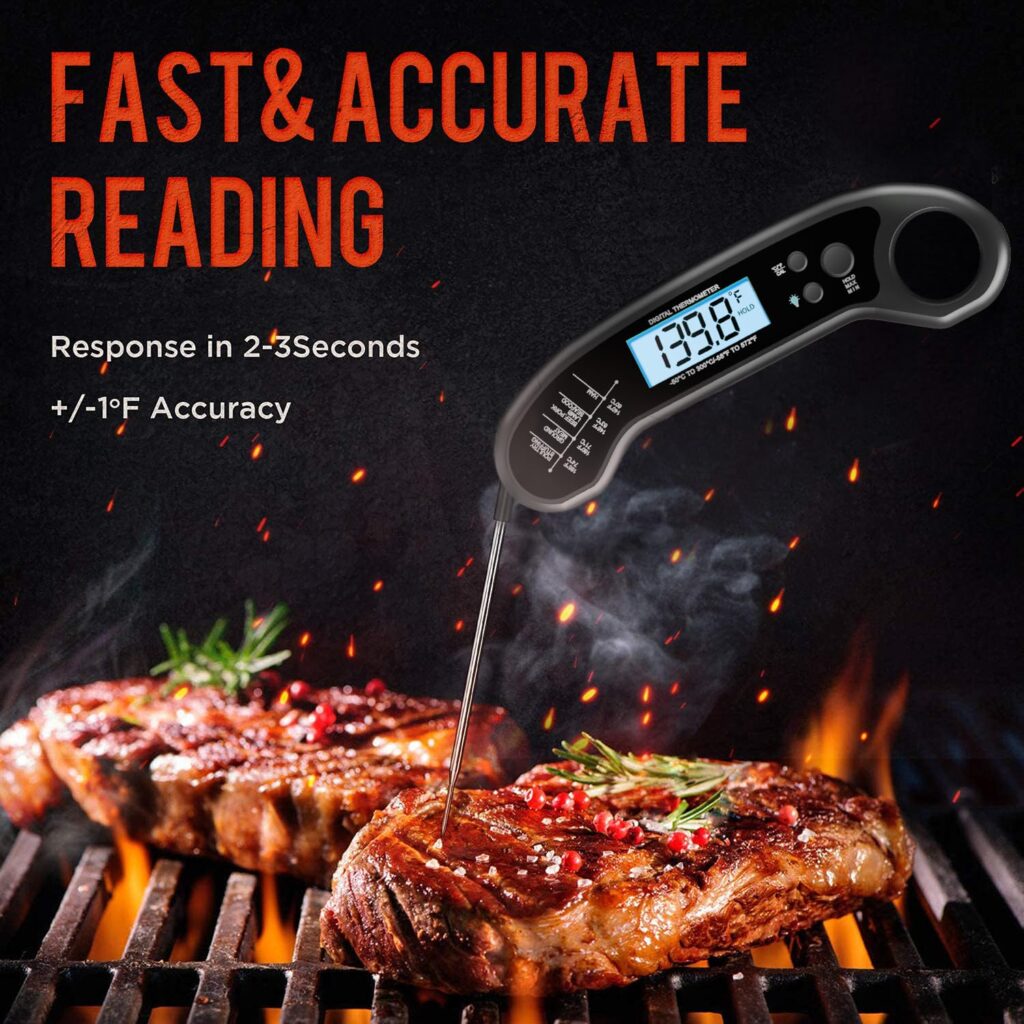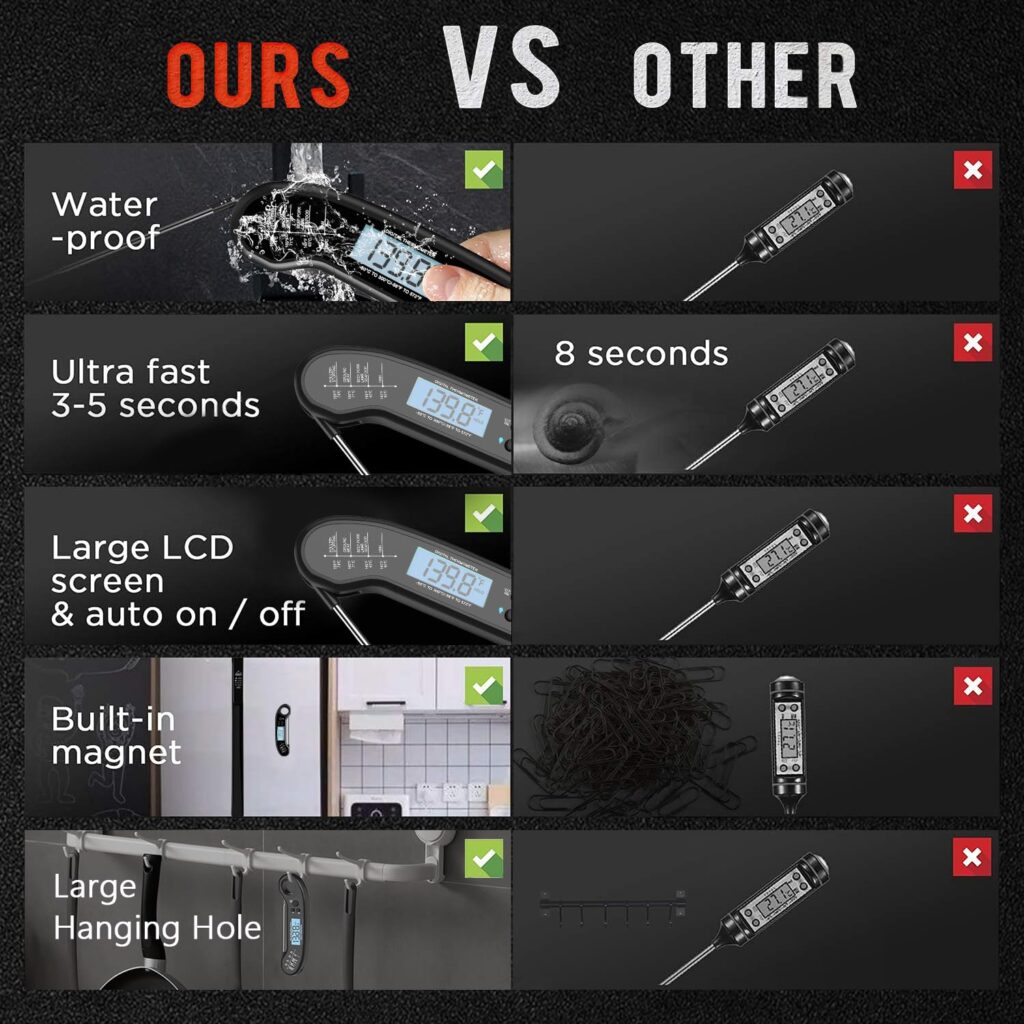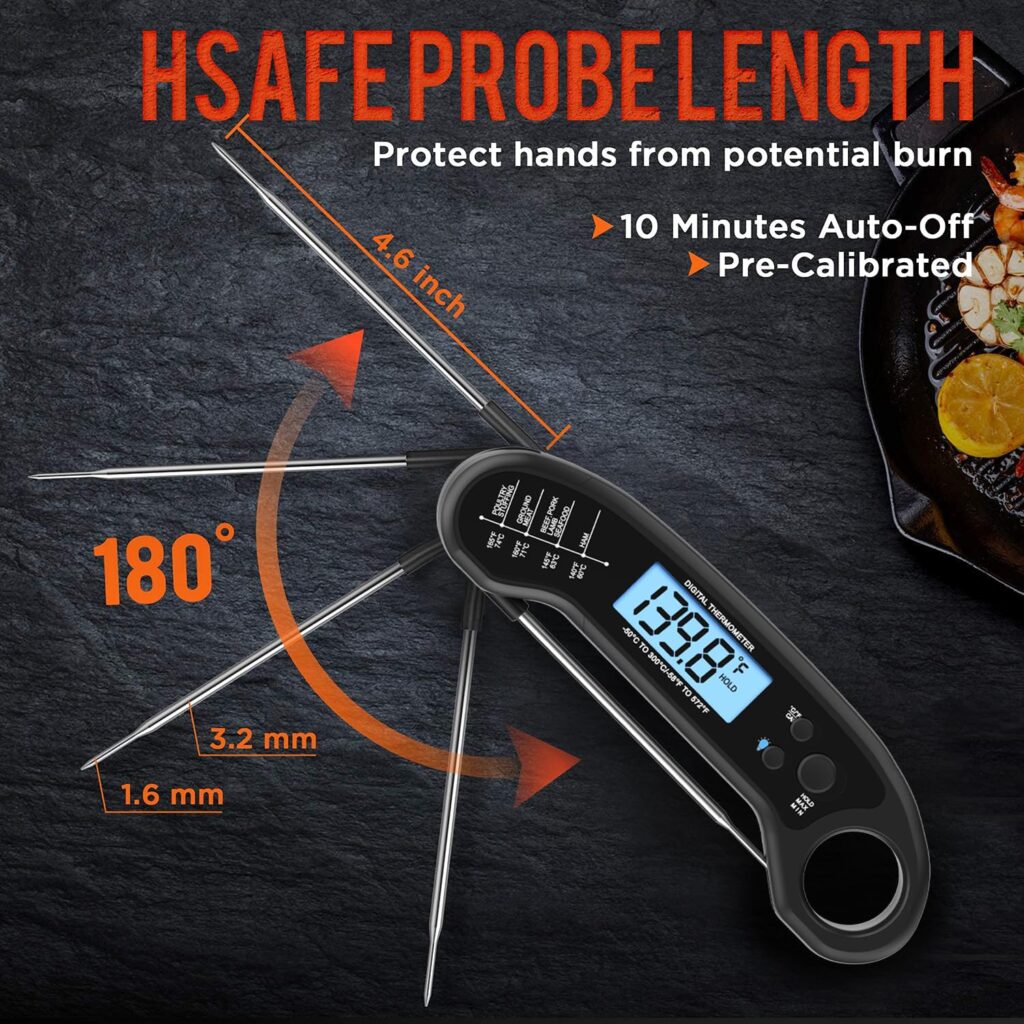Interested in a reliable instant-read thermometer that works for both your backyard BBQ and weekday kitchen meals?
This image is property of Amazon.com.
Product Overview
You get the Meat Thermometer Digital, Instant Read Meat ThermometerI for Grill and Cooking, Waterproof Food Thermometer for Kitchen and Outside, BBQ, Turkey, Candy, Liquids, Beef — a compact, one-button digital thermometer built to remove guesswork from cooking. The unit aims to be fast, accurate, and durable so you can check temperatures for everything from frozen items to hot oil without fuss.
Meat Thermometer Digital, Instant Read Meat ThermometerI for Grill and Cooking, Waterproof Food Thermometer for Kitchen and Outside, BBQ, Turkey, Candy, Liquids, Beef
$9.48 In Stock
Key Features
This thermometer packs several practical features that matter when you cook regularly or host outdoor gatherings. Each element is designed to make measurements faster, safer, and easier to read in varied lighting and weather conditions.
Instant Read and Fast Response
You’ll appreciate the 2–3 second response time for most readings, which keeps heat loss minimal and gives you near-instant feedback. Fast reads are especially helpful when you’re checking thin cuts of meat or quickly testing multiple items on the grill.
Wide Temperature Range and Accuracy
The thermometer measures from -58°F to 572°F (roughly -50°C to 300°C) with an accuracy of ±1°F, so it covers everything from frozen ingredients to deep-frying oil. That range is useful if you cook candy, roast turkeys, or temper chocolate, and you’ll notice consistent results across those temperatures.
Food-Grade 304 Stainless Steel Probe
The probe is 304 stainless steel, which is safe for food contact and easy to clean after use. You can stick it into meats, sauces, or baby food without concern for contamination or rapid corrosion.
Waterproof and Durable Design
Waterproof protection helps prevent damage during use and when you rinse the device after cooking, making it more durable for outdoor grilling. The housing and probe materials are chosen to withstand regular kitchen or BBQ use and occasional splashes or drips.
Large Backlit LCD and Display
A large, backlit LCD gives clear readings even at night or when smoke and dim lighting make it hard to see. The backlight means you won’t need to rely on your phone flashlight or carry additional lighting when grilling after sunset.
Magnetic Back and Hanging Hole for Storage
A built-in magnet and large hanging hole let you attach the thermometer to a fridge, oven, or hook for quick access. This keeps the tool handy while you work and reduces clutter in busy cooking environments.
Celsius/Fahrenheit Switch and One-Click Operation
Switch easily between Celsius and Fahrenheit with a single button, and take readings with a one-click operation that’s friendly for beginners. The device is designed to be intuitive so you can focus on cooking rather than learning complex menus.
Technical Specifications
Below is a concise breakdown of the thermometer’s core specs so you can scan them quickly and see if it fits your needs.
| Feature | Specification |
|---|---|
| Product Name | Meat Thermometer Digital, Instant Read Meat ThermometerI |
| Temperature Range | -58°F to 572°F (-50°C to 300°C) |
| Accuracy | ±1°F |
| Response Time | ~2–3 seconds |
| Probe Material | 304 stainless steel |
| Display | Large LCD with backlight |
| Waterproof Feature | Yes (splash/protection for cleaning and outdoor use) |
| Operation | One-click measurement; C/F selectable |
| Storage Features | Built-in magnet, hanging hole |
| Typical Uses | BBQ, turkey, candy, liquids, beef, general cooking |
These specs cover the essentials and should help you decide whether the thermometer matches your cooking style and needs.
Unboxing and First Impressions
When you open the package, you’ll notice a compact device with a foldable probe and a straightforward control layout. The build feels light but solid, and the stainless-steel probe gives an immediate sense of quality.
You’ll likely find the included printed temperature references helpful since common meat types and target temperatures are marked on the body, making quick checks easier for beginners. The display is clear; the backlight is bright enough for nighttime grilling and doesn’t glare.
This image is property of Amazon.com.
How to Use
Using the thermometer is intentionally simple so you can get accurate results without reading a long manual. These steps cover common scenarios so you can use the tool confidently in different cooking contexts.
Preparing the Thermometer
Turn on the thermometer with a single press and select Celsius or Fahrenheit if you prefer the alternate scale. Ensure the probe is clean and dry, and unfold it until it locks into place if it’s a foldable model.
When placing the thermometer into food, hold it by the housing to avoid heat transfer from your hand and to keep the probe oriented correctly for accurate readings. If measuring thin cuts, insert the probe at an angle to reach the center without pushing it all the way through.
Measuring Meat and Poultry
Insert the probe into the thickest part of the meat, avoiding bone and fat pockets, to get core temperature readings. For whole poultry like turkey, place the probe in the inner thigh near the breast but not touching bone for an accurate internal temperature.
Wait for the reading to stabilize (2–3 seconds) and use the printed reference on the device body to match safe doneness temperatures for different meat types. Remove the probe carefully and allow the meat to rest if required to reach ultimate juiciness and even temperature distribution.
Measuring Candy, Liquids, and Oil
For candy and sugar syrups, hold the probe tip in the syrup without letting it touch the pot bottom to avoid false high readings. For frying oil, insert the probe just enough to reach the target temperature while keeping the handle and electronics away from splashes.
If measuring liquids like sauces or stocks, stir gently and then place the probe in the center of the pot to get a representative reading. Always use caution with boiling liquids and hot oil to prevent splashes and burns.
Cleaning and Maintenance
After use, wipe the probe with a damp cloth or rinse the metal portion under running water while keeping the body above water to avoid soaking the electronics. Avoid abrasive cleaners and do not submerge the entire device unless it’s specifically rated for full submersion.
Dry the probe and housing thoroughly before storing to prevent moisture-related issues, and keep batteries fresh to maintain accurate readings. If the probe gets sticky from sugar or sauces, soak the probe tip briefly in warm water and mild detergent to remove residue.
Accuracy and Performance Tests
When you rely on temperature for safety and quality, consistent accuracy matters most. The thermometer’s ±1°F stated accuracy is competitive for instant-read devices and generally reliable across typical culinary ranges.
A few practical tests demonstrate how the unit behaves in real life: it delivers quick readings on steaks and burgers, provides consistent candy temperatures when you keep the probe off the pot bottom, and performs well in outdoor smoky conditions thanks to its backlit display and quick response time.
Response Time Results
The advertised 2–3 second response is realistic for thin meats and liquids, meaning you won’t need to hold the probe in place for long and risk heat loss or overcooking. For thick roasts or whole poultry, the probe may take slightly longer to show true core temperature, so allow an extra moment for stabilization.
In high-volume grilling situations, the quick read time helps you test multiple pieces across the grate without losing much heat from the food. For very viscous syrups or dense candy, the reading may take a beat longer as the probe equilibrates with the local temperature.
Accuracy Across the Temperature Range
Within typical cooking ranges (32°F–212°F), the thermometer generally stays within the ±1°F accuracy claim when used correctly. At extreme ends of the spectrum, such as near the lower or upper limits (-58°F or 572°F), calibration drift and environmental factors may slightly affect readings.
For most household and outdoor cooking tasks, the accuracy provided is more than adequate for ensuring safe internal temperatures and consistent doneness. If you need laboratory-grade accuracy for specialized processes, consider a calibrated professional instrument.
Performance in Outdoor BBQ Conditions
Outside the kitchen, the thermometer’s waterproofing and backlit screen make it convenient around smoke, grease, and evening grilling sessions. The magnetic back and hanging hole help keep the device accessible on the grill cart or a nearby metal surface.
Wind and ambient temperature don’t materially impact probe readings when you insert the probe properly into the food, though you should avoid exposing the device body directly to open flames or excessive heat.
This image is property of Amazon.com.
Pros and Cons
You’ll find practical strengths and a few limitations when evaluating whether this thermometer fits your routine. Consider these points to decide how it matches your cooking frequency and environments.
Pros:
- Fast 2–3 second reads reduce heat loss and speed up checks.
- Wide temperature range suits candy-making, frying, and freezing.
- Food-grade 304 stainless steel probe is durable and safe.
- Large backlit display improves readability in low light.
- Waterproof design and sturdy build hold up for outdoor use.
- Magnetic back and hanging hole make storage easy.
Cons:
- The probe length may be short for very large roasts unless you angle it carefully.
- For long-term oven monitoring, a leave-in probe or wireless thermometer would be more convenient.
- Battery life depends on usage and screen/backlight time; keeping spare batteries is wise.
Comparison with Other Thermometers
Comparing tools helps you choose the best fit for specific tasks like smoking a brisket versus boiling candy. This digital instant-read thermometer aims to be versatile, but it’s helpful to compare it against two common alternatives.
Instant-Read vs. Leave-In Probes: Instant-read models like this one deliver quick spot checks and minimize food puncture damage, but don’t offer continuous monitoring. Leave-in probes and wired oven thermometers provide constant temperature logging, which is better for long roasts or low-and-slow smoking.
Instant-Read vs. Wireless/Wi-Fi Thermometers: Wireless thermometers let you monitor from a distance and receive alerts, which is great for multi-hour smoking sessions. This device trades remote monitoring for simplicity, speed, and a lower price point.
If you need one reliable tool for everyday cooking and occasional BBQ, this thermometer covers a wide range of tasks with good accuracy. If you routinely leave meat in the oven for hours or need remote alerts, you might want an additional device designed specifically for continuous monitoring.
This image is property of Amazon.com.
Safety and Food Handling Tips
Using the thermometer correctly helps you avoid cross-contamination and ensures food safety for family and guests. A few straightforward precautions keep temperatures accurate and prevent foodborne illness.
Always clean and sanitize the probe between uses, especially when switching between raw and cooked foods or testing multiple items. Avoid touching the probe tip with bare hands after it’s been in raw meat, and use a separate cloth or wipes if needed.
When measuring poultry and large roasts, place the probe in the thickest part away from bone and fat to get the true internal temperature. If testing baby food or items for vulnerable people, double-check readings and allow the food to rest if needed to evenly distribute heat.
Troubleshooting and FAQs
You’ll rarely need to troubleshoot, but knowing common fixes saves time and frustration if readings act odd. These FAQ-style tips cover typical issues and their likely solutions.
Why does the temperature jump around?
Rapid fluctuations often happen when the probe is near bone, fat, or the pot bottom, which can read higher or lower than the meat’s true center. Reposition the probe to the thickest, center portion of the food and hold steady until the display stabilizes.
The screen is hard to read in bright sunlight — any tips?
In bright daylight, tilt the screen to reduce glare, or step into shaded areas for a clearer view; the backlight may be less effective in direct sun. If you often work in bright outdoor conditions, consider a small handheld shade or hold the thermometer close to your body when reading.
Can I calibrate this thermometer?
Many consumer instant-read thermometers can be checked using an ice bath (0°C/32°F) and boiling water (~212°F at sea level) as reference points. If readings are off significantly, consult the manual for reset or calibration instructions; if calibration isn’t supported, consider returning or replacing the unit.
Is it safe to leave the probe in food while resting?
This model is designed primarily for instant reads, not continuous high-temperature exposure inside an oven for long periods. For resting and continuous monitoring, a leave-in probe designed for prolonged exposure is safer and avoids damaging the probe or electronics.
How do I extend battery life?
Turn off the device when not in use, avoid leaving the backlight on unnecessarily, and remove batteries if storing the thermometer for long periods. Keep a spare battery on hand so you’re never caught mid-cook without power.
This image is property of Amazon.com.
Care, Storage, and Longevity
Treating the thermometer with basic care will prolong its useful life and maintain accuracy over years of cooking. You’ll get the most value by following a few simple practices.
After each use, wipe the probe clean and rinse if needed, making sure not to soak the electronic housing beyond its waterproof rating. Store the thermometer folded (if foldable) in a dry place; use the magnet to attach it to your fridge or hang it by the hole to keep it accessible.
Replace batteries as they weaken to maintain reliable backlight and measurement speed, and avoid dropping the device onto hard surfaces which can bend the probe or damage internal sensors. If the probe becomes visibly worn or bent, replacement is a better option than attempting repair.
Who Should Buy This Product
If you cook regularly, host outdoor barbecues, or are learning to cook meats safely, this thermometer suits your needs well. It’s ideal for home cooks who want a single, reliable tool for steaks, turkeys, candies, and liquids without investing in more complex monitoring systems.
You might skip this model if you need continuous remote monitoring for multi-hour smoking sessions or require industrial-grade calibration for professional food service. Otherwise, it’s a very practical, budget-friendly gadget for everyday and occasional gourmet tasks.
Best Practices for Different Cooking Scenarios
You’ll get better results when you match the thermometer technique to the cooking task. These scenario-specific tips help ensure accurate readings and better final dishes.
Steaks and Burgers: Insert the probe sideways into the center for thin steaks and directly into the thickest point for burgers; quick reads will help prevent overcooking. Use the printed temperature guide on the device if you’re unsure about desired doneness levels.
Whole Turkey or Large Roasts: For whole poultry, aim for the inner thigh near the breast and avoid bone contact; for roasts, measure the geometric center of the thickest section. Allow resting time since temperature can continue to rise slightly after removing the meat from heat.
Candy and Syrups: Keep the probe tip immersed but avoid touching the pot bottom to prevent misleading high readings. Stir the syrup and then measure to ensure the probe is sampling the bulk temperature rather than a hot spot.
Frying: Lower the probe gently into the oil without letting the handle get too hot; monitor frequently to avoid overheating and burning. Use the thermometer to maintain safe frying temperatures rather than relying purely on visual cues.
Accessories and Add-Ons Worth Considering
A few simple accessories can enhance the thermometer’s utility and longevity. These small add-ons are inexpensive but useful for frequent cooks.
Protective sheath or probe cover protects the tip during storage and prevents accidental pokes. A dedicated cleaning brush or sanitizing wipes help keep the probe hygienic between tasks. Spare batteries and a small carrying case make it easier to grab the device for outdoor grilling or travel.
If you plan long cooks, consider pairing this instant-read thermometer with a leave-in wired probe or a wireless thermometer for continuous monitoring and alerts while you’re away from the grill.
Final Verdict
You’ll find that the Meat Thermometer Digital, Instant Read Meat ThermometerI for Grill and Cooking, Waterproof Food Thermometer for Kitchen and Outside, BBQ, Turkey, Candy, Liquids, Beef is a practical, user-friendly tool that meets the needs of most home cooks. Its fast response, wide temperature range, and convenient features like backlighting and magnetic storage make it a reliable companion for everyday cooking and outdoor barbecues.
If you want a single, affordable device that improves food safety and helps you hit the ideal doneness every time, this thermometer is a solid buy. For specialized long-term monitoring or lab-level precision, add a secondary tool targeted to those needs, but for general home and outdoor use, this thermometer will serve you very well.
Disclosure: As an Amazon Associate, I earn from qualifying purchases.

